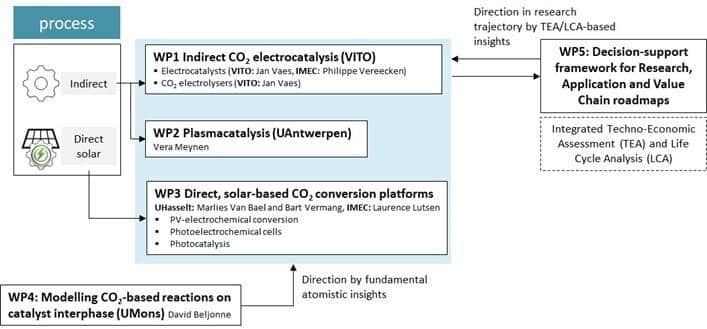T-REX – On the transition to more renewable energy in power-to-X applications
T-REX focuses on Power-to-X, the use of electricity to produce other fuels and raw materials. The project focuses on the conversion of CO2 into renewable materials via electrified routes. By making direct use of solar energy or connecting to a green grid, this project aims to increase the share of renewable energy in Belgium as much as possible. The detailed analysis of the catalysts, their stability and efficiency are central to the project and is supported by reaction modelling and techno-economic and life cycle analysis.
The EU has committed itself to a renewable energy transition and contribution to reach the Paris Agreement goals on climate change, limiting the average global temperature increase to well below 2°C before 2100. This was translated in a EU legislation with binding climate and energy targets for 2030 including each Member States National Energy and Climate Plan (NECP), setting out how to reach its national targets. The Belgian climate ambitions involve a 35% GHG reduction compared to 2005 by 2030 and at least 80% reduction compared to 1990 by 2050. It is clear that the impact of corresponding measures on competitiveness should be minimized for the industry. As the refining, chemical, iron & steel industries are energy-intensive and important CO2 emitters, appropriate technologies should be developed and implemented to realize this shift. This involves the decarbonization of energy production and ‘de-fossilization’ of fuel and chemical production, and encompasses different stakeholders, such as the industry, mobility and energy sector.
The large-scale deployment of renewable energy production requires buffering solutions, due to its intermittent nature, to stabilize the electricity grid. Depending on the operational boundary conditions, different strategies are available such as batteries for short-term storage, while Power-to-X approaches allow to store large seasonal electricity surpluses in chemical energy, in the form of hydrogen or liquid fuels. In the other sense, the Carbon Capture and Utilization (CCU) strategies rely on low-carbon energy, next to CO2 as carbon feedstock. For the setup of economic feasible value chains, recommendations were done in the European SET (Strategic Energy Technologies) Implementation plan, by WG9 in the context of CCU and CCS. These insights serve as the starting point for the T-REX project, as illustrated in Figure 1.

The (intermittent) availability of renewable electricity is taken as main boundary condition and value chains assessed, based on fully electrified, direct-solar and indirect grid-linked CO2 conversion processes (Figure 2). Ideally, these technologies can handle less pure CO2 streams (% content and impurities) from different industrial sources to lower upstream CO2 capture and pre-treatment costs. For this purpose, the processes would rely on robust catalyst systems, that enable high operational stability and overall energy efficiency. The full potential/impact is evaluated on roadmaps and their ambitions/targets for CO2 reduction, considering timeline and geography and positioned together with other heat-driven and/or H2 mediated CO2 conversion processes. The focus is on renewable fuels as relevant CCU end products (methanol, ethanol and H2) with given production cost and environmental footprint and their fit within regulatory frameworks (REDII).

The T-REX project consists of 3 work packages (WP1-3), that involve low TRL research within the process technology platforms of electro-, plasma- and photo-based catalysis (Figure 3). This is supported by fundamental atomistic insights by models on CO2-based reactions on the catalyst interphase in WP4. The research parameters and their sensitivity on the innovation’s feasibility are evaluated in WP5 by techno-economic models to set research targets, direct and follow-up the trajectory. In parallel and integrated with life cycle analysis the outcome is used in a decision-support framework and technology positioning in roadmaps (e.g. Deloitte’s roadmap study and context analysis on carbon circular and low-carbon Flemish Industry, Dechema roadmap and position paper, …) together with proper innovation benchmarks and the state-of-the-art.





